
Echeverias grow in the form of rosettes of leaves or as small bushes. The number of Echeveria species and hybrids seems almost endless. That's why we looked for the most beautiful echeverias for you.
To the point
- Echeverias are thick-leaved plants
- over 150 Echeveria species and countless hybrids
- come predominantly from Mexico
- Leaves and rosettes make them attractive foliage plants
- very robust and easy to care for
Table of contents
- Echeveria species
- From A to C
- From D to S
- Echeveria hybrids
- frequently asked Questions
Echeveria species
Echeverias impress with their fleshy leaves and colorful rosettes. Below we will introduce you to the most popular Echeveria species and also make recommendations for particularly beautiful varieties.
From A to C
Echeveria affinis

Source: Michael Wolf, Echeveria affinis 02, Edited by Plantopedia, CC BY-SA 3.0
Echeveria affinis forms dense, short-stemmed rosettes. The name “Black Echeveria” goes back to the dark leaves of the species.
- Leaf rosette diameter: up to 15 centimeters
- Color leaves: brownish-olive with a yellowish-green base, up to 5 centimeters long and 2 centimeters wide
- Flowers: bell-shaped, bright red, in clusters on upright stems in summer
Cultivars or varieties of Echeveria affinis have not yet been described. However, the species is a parent of well-known and popular hybrids such as “Black Knight” or “Black Prince”.
Echeveria agavoides
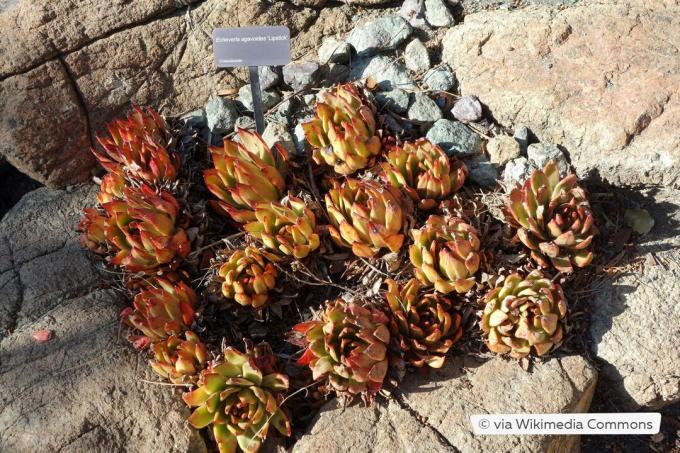
Source: Daderot, Echeveria agavoides 'Lipstick' - Leaning Pine Arboretum - DSC05749, Edited by Plantopedia, CC0 1.0
This stemless Echeveria species forms dense rosettes that usually stand alone.
- Leaf rosette diameter: up to 30 centimeters
- Leaves: apple green, triangular with terminal spines, reddish edges possible in bright sunlight
- Flowers: pink-red or orange, in spring and early summer on inflorescences up to 30 centimeters high
Echeveria agavoides “Lipstick”
- Rosette of leaves up to 60 centimeters in diameter
- Leaves: apple green to yellowish-green with a red edge and terminal spine, up to 8 centimeters long and 4 centimeters wide
Echeveria agavoides “Romeo Ruby”
- deep purple (ruby red) leaves with terminal thorns
- slightly smaller flowers than other varieties of Echeveria agavoides
A notice: Echeverias are slightly poisonous and therefore not suitable for consumption. Since the toxins are found in the plant sap, you should wash your hands thoroughly after handling the plant.
Echeveria atropurpurea
Large rosettes of leaves on short, strong stems make Echeveria atropurpurea one of the most beautiful Echeverias.
- Leaf rosette diameter: up to 20 centimeters
- Leaves: reddish-brown, shiny, obovate or spatulate, up to 12.5 centimeters long and 5 centimeters wide
- Flowers: bright red, in winter on upright stems up to 30 centimeters high
- No cultivars or varieties have been described yet
- Parent of the hybrid “Brown Sugar”
Echeveria australis
Echeveria australis is native to Costa Rica and Panama. Unlike many other Echeveria species, it grows as a succulent bush.
- Height: up to 30 centimeters, including inflorescence up to 60 centimeters
- Leaves: light green, often with a purple tint and glaucous in color, obovate or spatulate, up to 7 centimeters long and 3 centimeters wide
- Flowers: bright red, bell-shaped, in winter
- No cultivars or varieties have been described yet
Echeveria cante

Source: HAbrOlR, Echeveria cante25, Edited by Plantopedia, CC BY-SA 4.0
Echeveria cante grows as a single rosette. Since it does not form offshoots, it is propagated via leaf cuttings.
- Leaf rosette diameter: up to 40 centimeters
- Leaves: lavender-colored / pale bluish-green with a white powdery coating, often thin-edged pink leaf edges
- Flowers: orange-pink, branched upright stems up to 60 centimeters high with four to twelve flowers per branch
Descriptions of varieties or varieties of Echeveria cante are not yet available. However, it acts as a parent of various hybrids such as “Encantada” or “Morning Beauty”.
Echeveria colorata
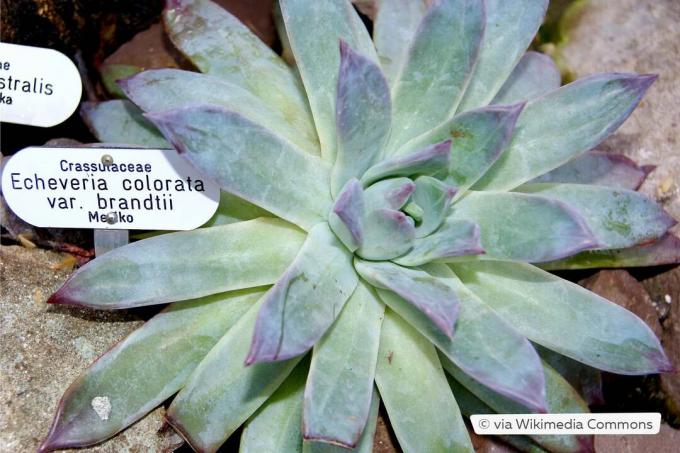
Source: NasserHalaweh, Crassulaceae Echeveria colorata var. brandtii 1, Edited by Plantopedia, CC BY-SA 4.0
Echeveria colorata usually forms a large, single rosette with arched leaves.
- Leaf rosette diameter: up to 20 centimeters
- Leaves: lance-shaped, yellowish-green to whitish with a fine tip edged in red
- Flowers: pink, bell-shaped, on curved stems in spring
Echeveria colorata var. brandtii
- bluish-green, elongated leaves with a pointed end
- reddish-pink edges in full sun locations
Echeveria colorata “Mexican Giant”
- shimmering leaves, silver gray and various shades of purple, covered with a white wax layer
- Rosette of leaves up to 40 centimeters in diameter
From D to S
Echeveria derenbergii
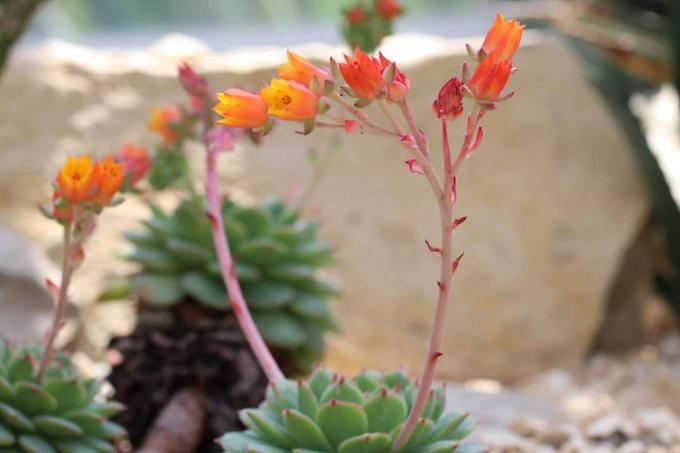
Make dense pagoda-shaped rosettes Echeveria derenbergii one of the most beautiful Echeveria species. Since it produces daughter plants at a young age, an echeveria carpet is created in a short time.
- Leaf rosette diameter: up to 8 centimeters
- Leaves: light green, more or less glassy, reddish edges and tips, obovate with a short sharp tip, fleshy, up to four centimeters long and 2.5 centimeters wide
- Flowers: cup-shaped, yellow-orange with red tips on pink-red stems, late winter to summer
Cultivars or varieties of Echeveria derenbergii have not yet been described. In breeding, for example, it is a parent of “Ben Badis” or “Victor”.
Echeveria elegans
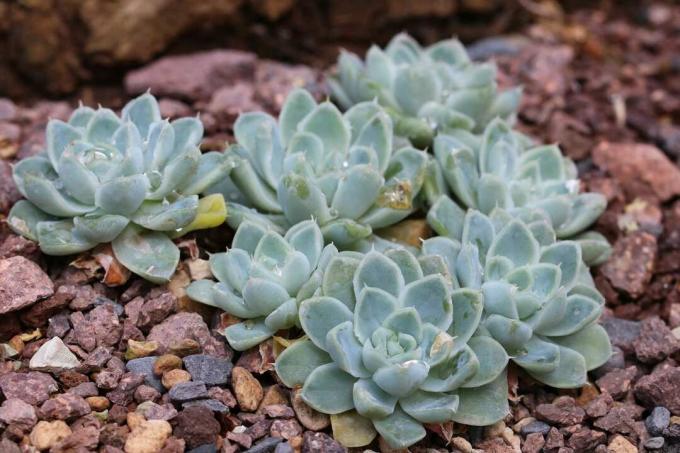
The compact leaf rosettes of Echeveria elegans form a dense carpet of rosettes over time. The species is native to the semi-desert regions of Mexico and is often called the “Mexican Snowball” because of its color.
- Leaf rosette diameter: up to 30 centimeters
- Leaves: pale bluish-green, up to 6 centimeters long and 2 centimeters wide
- Flowers: pink-red with yellow tips on pink stems up to 30 centimeters high from late winter to mid-summer
A notice: If Echeveria elegans is in bright sunlight, its leaves can take on a pink color.
Echeveria elegans “Albicans”
- Rosette about 10 centimeters in diameter, forms clumps
- very thick, light olive to silvery-white leaves, frosted
Echeveria gibbiflora

- Leaf rosette diameter: up to 20 centimeters
- Leaves: green, silvery
- Flowers: red with yellow tips, shoots up to 50 centimeters long
Echeveria gibbiflora ‘Metallica’
- silvery foliage with large rosettes
- in the right location (full sun), leaves turn pink-purple
- ideal Rock garden plant
Echeveria setosa

Source: NasserHalaweh, Crassulaceae Echeveria setosa var. deminuta 1, Edited by Plantopedia, CC BY-SA 4.0
Echeveria setosa is a simple species, but is still one of the most beautiful echeverias.
- Leaf rosette diameter: up to 12 centimeters
- Leaves: green with white pubescence, spoon-shaped, up to 7 centimeters long and 2 centimeters wide
- Flowers: orange-red with yellow tips, spring to summer on stems up to 30 centimeters long
Echeveria setosa var. deminuta
- blue-green, club-shaped leaves, no hairs
- Rosettes max. 7 centimeters
Echeveria setosa var. minor
- pale blue to blue-green leaves with white hairs, lanceolate or spatulate
- Rosettes max. 7 centimeters with densely packed leaves
Echeveria hybrids
Echeveria “Can Can”
The hybrid “Can Can” forms a large rosette. “Can Can” is a breed by Dick Wright, the exact parents are unknown.
- Leaf rosette diameter: up to 35 centimeters
- Color: copper-green, brown-violet with age
- red ruffled leaf edges
- Flowers: reddish-pink, in summer
Echeveria 'Compton Carousel'

Source: Isaac Bee, Echeveria Compton Carousel, Edited by Plantopedia, CC BY-SA 4.0
“Compton Carousel” is a hybrid of Echeveria secunda and Echeveria gibbiflora “Metallica.” The echeveria forms dense rosettes that are close together. (“lump”)
- Leaf rosette diameter: up to 20 centimeters
- Color: blue-gray with a wide cream-colored edge
- older leaves with a hint of pink
- Flowers: red with a yellow tip on inflorescences up to 30 centimeters long
Echeveria “Crispate Beauty”
“Crispate Beauty”, a mutation of Echeveria lilachina, is one of the most beautiful, smaller echeverias.
- Leaf rosette diameter: up to 15 centimeters
- Color: brownish-green covered with white wax powder
- heavily ruffled leaf edges
- Flowers: coral pink, wavy tips, in clusters on leafy, arched stems in summer
Echeveria “Cubic Frost Cristata”
“Cubic Frost Cristata” is a special form of the hybrid “Cubic Frost”.
- Color: purple-pink to cool purple
- Leaves sit close to the tip of a crown-shaped stem (“growths”)
A notice: The growth habit of each specimen of “Cubic Frost Cristata” is unique.
Echeveria “Linguas”

The shape and color of the leaves make the hybrid Echeveria “Linguas” one of the most beautiful echeverias. It grows as a single rosette but can produce daughter plants as it ages. “Linguas” was created in 2008 by the American echeveria breeder Dick Wright.
- Leaf rosette diameter: up to 25 centimeters
- Color: coral blue in winter, reddish pink in summer
- pink wavy leaf edges
- Top of leaf covered with caruncles
- Flowers: pink, on long branched stems in summer
Echeveria “Neon Breakers”
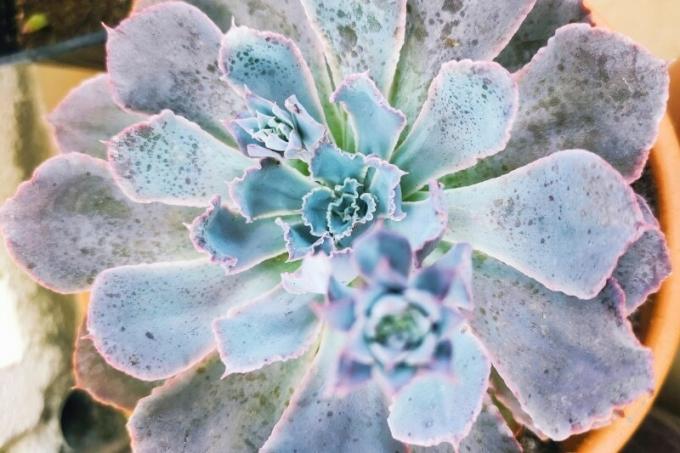
“Neon Breakers” is one of the most beautiful Echeveria hybrids because of its color. The parents of the patented hybrid are Echeveria saviana and Echeveria cante x saviana.
- Leaf rosette diameter: up to 20 centimeters
- Color: shades of blue-green, pink and purple with neon pink leaf edges
- more intense coloring in summer
- Flowers: deep pink on purple stems in spring and summer
Echeveria “Pearl of Nuremberg”
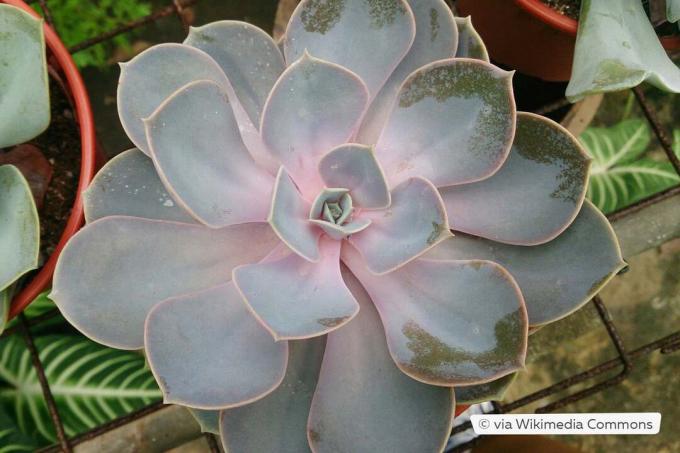
Source: Mokkie, Echeveria 'Pearl Of Nuremberg', Edited by Plantopedia, CC BY-SA 3.0
The hybrid “Pearl of Nuremberg” is one of the most popular and beautiful echeverias. The parents are Echeveria gibbiflora “Metallica” and Echeveria potosina, which is closely related to Echeveria elegans.
- Rosette diameter: up to 20 centimeters
- Color: blue-green with pink, red and purple tones, powdered
- Flowers: coral pink with a yellow interior, in summer on reddish inflorescences up to 30 centimeters long
A notice: “Rainbow” is the colorful variety of the “Pearl of Nuremberg”. Its pink-purple leaves shimmer irregularly in bright pink and light yellow.
Echeveria “Trumpet Pinky”

“Trumpet Pinky” is a random mutation of the hybrid Echeveria “Pinky.” Their tubular leaves are reminiscent of trumpets.
- Leaf rosette diameter: up to 25 centimeters
- Color: glassy green to bluish; Fading pink toward the leaf tips in full sun
- Flowers: reddish-orange, on arched spikes in spring
frequently asked Questions
Echeverias get by with little water. In summer it is sufficient if you give the thick-leaf plant a little water every week. In winter, “water” every three weeks. To avoid mold and leaf rosette rot, water only into the surrounding substrate.
Echeverias are not hardy. The lower temperature limit, even in winter quarters, is +8 degrees Celsius for many Echeveria species.
For Echeveria species that produce daughter plants, separate them for propagation. Other ways of propagation include seeds and leaf or stem cuttings.



